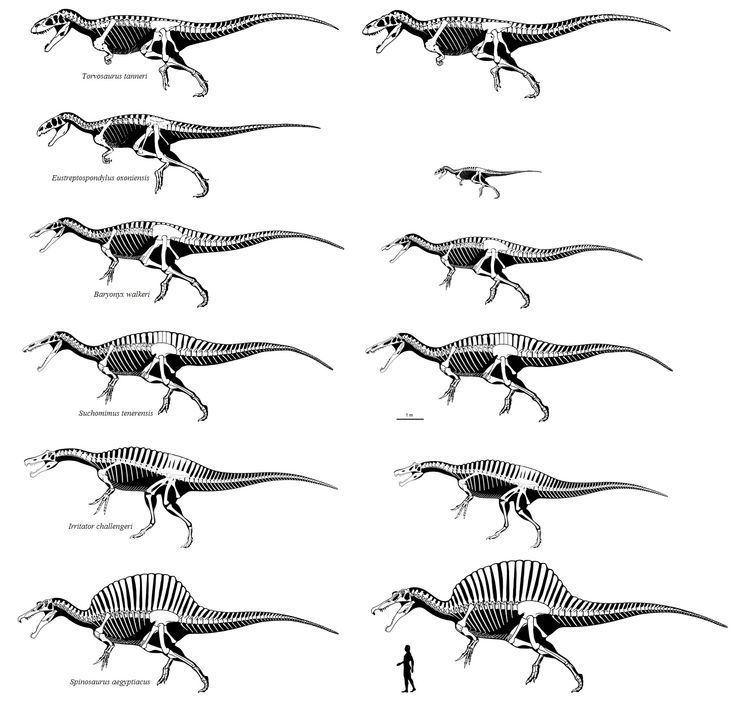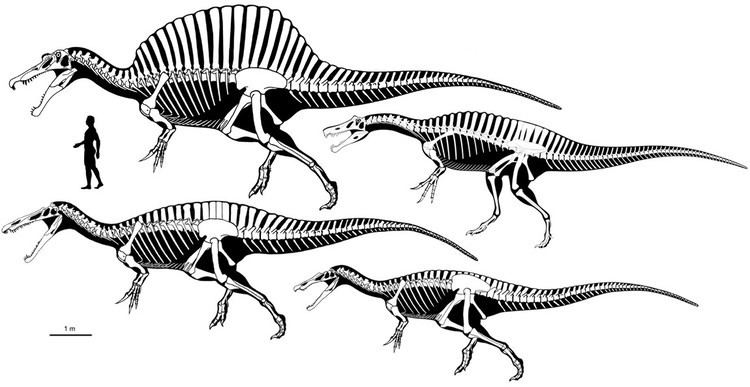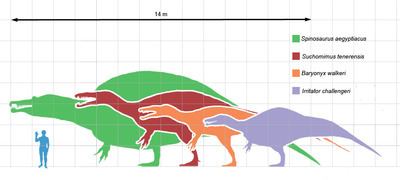Scientific name Spinosauridae Rank Family | Clade †Megalosauria Higher classification Theropods | |
 | ||
Lower classifications | ||
Spinosauridae is a family of specialised theropod dinosaurs. Members of this family were large predators with elongated, crocodile-like skulls, sporting conical teeth with no or only very tiny serrations. The front dentary teeth fanned out, giving the animal a characteristic look. The name of this family alludes to the typically conspicuous sail-like structure protruding from the back of species in the type genus, Spinosaurus. The purpose of the sail is disputed; while popular explanations are that it may have served as a thermoregulator, a threat display, or as a sexual display during courtship, some palaeontologists rather interpret the neural spine elongation in Spinosaurus as a support of a muscular/fatty hump.
Contents
- Evolutionary historyEdit
- Predatory behaviorEdit
- DietEdit
- HabitatEdit
- TaxonomyEdit
- ClassificationEdit
- References

Spinosaurid fossils have been recovered in Africa, Europe, South America, Asia, and Australia.
Evolutionary historyEdit

The first spinosaurids appeared during the Late Jurassic and became abundant in the Early Cretaceous. So far, the Late Jurassic record of spinosaurids consists only of referred teeth, dating to 155 million years ago. They seem to have declined sharply in the Cenomanian, and while teeth from the Turonian of Argentina have been attributed to spinosaurid dinosaurs, they recently turned out to be crurotarsan teeth. Some are known to have persisted into the mid-Santonian, represented by a single baryonychine tooth found in the Majiacun Formation of Henan, China. There are also possible indeterminate remains of Spinosaurids in the Maevarano Formation, a formation of the Late Maastrichtian, possibly hinting the Spinosaurids may have made it to the Cretaceous-Paleogene boundary.
Predatory behaviorEdit

Studies of spinosaurids (specifically of Irritator) have shown that they had a very different skull shape and construction compared to other large predatory dinosaurs like Allosaurus and Tyrannosaurus. In most predatory dinosaurs, the jaws were broad either in width, height, or both, while spinosaurid jaws were thin and narrow. This led paleontologists like Sues, Frey and Martill to conclude that spinosaurids, unlike other theropods, were not specialized in attacking large, struggling prey.
Sues and colleagues studied the construction of the spinosaurid skull, and concluded that their mode of feeding was to use extremely quick, powerful strikes to seize small prey items with the jaws, employing the powerful neck muscles in rapid up-and-down motion. Due to the narrow snout, powerful side-to-side motion of the skull in prey capture is unlikely.
DietEdit

Spinosaurids have in the past often been considered mainly fish-eaters (piscivores), based on comparisons of their jaws with the jaws of modern crocodilians. Rayfield and colleagues, in 2007, were the first to conduct actual biomechanical studies on a spinosaurid skull (using the European spinosaurid Baryonyx). They found that the structure and bite force of baryonychine jaws was almost identical to modern gharials, supporting the idea that at least baryonychines were mainly fish-eaters, though the jaws of spinosaurines appear to have been more generalized. However, a study by Cuff and Rayfield (2013) on the skulls of Spinosaurus and Baryonyx concluded that bio-mechanical data suggests that these spinosaurs were not obligate piscivores and that their diet was more closely associated with the individual spinosaur'S size. The characteristic rostral morphology of these spinosaurs allowed their jaws to resist bending in the vertical direction, particularly in Baryonyx walkeri, but the jaws of both species were poorly adapted with respect to resisting lateral bending.
Direct fossil evidence shows that spinosaurids fed on fish as well as a variety of other small to medium-sized animals, including small dinosaurs. Baryonyx was found with fish scales and the digested bones of a young Iguanodon in its stomach cavity, and there is one documented example of a spinosaurid having eaten a pterosaur. It is likely that spinosaurids were generalists specializing in small prey of any kind, fish included.
HabitatEdit
A 2010 publication by Romain Amiot and colleagues found that oxygen isotope ratios of spinosaurid bones indicates semiaquatic lifestyles. Isotope ratios from teeth from the spinosaurids Baryonyx, Irritator, Siamosaurus, and Spinosaurus were compared with isotopic compositions from contemporaneous theropods, turtles, and crocodilians. The study found that, among theropods, spinosaurid isotope ratios were closer to those of turtles and crocodilians. Siamosaurus specimens tended to have the largest difference from the ratios of other theropods, and Spinosaurus tended to have the least difference. The authors concluded that spinosaurids, like modern crocodilians and hippopotamuses, spent much of their daily lives in water. The authors also suggested that semiaquatic habits and piscivory in spinosaurids can explain how spinosaurids coexisted with other large theropods: by feeding on different prey items and living in different habitats, the different types of theropods would have been out of direct competition.
TaxonomyEdit
The family Spinosauridae was named by Ernst Stromer in 1915 to include the single genus Spinosaurus. The family was expanded as more close relatives of Spinosaurus were uncovered. The first cladistic definition of Spinosauridae was provided by Paul Sereno in 1998 (as "All spinosaurids closer to Spinosaurus than to Torvosaurus).
The Spinosauridae family comprises two subfamilies: Spinosaurinae and Baryonychinae. Spinosaurinae was designated by Sereno in 1998 and later defined by Holtz et al. in 2004 as encompassing all taxa more closely related to Spinosaurus aegyptiacus than to Baryonyx walkeri. Meanwhile, Baryonychinae was identified by Charig & Milner in 1986. They erected both the subfamily and the family Baryonychidae for the newly discovered Baryonyx, before it was referred to the Spinosauridae. Their subfamily was defined by Holtz et al. in 2004, as the complementary clade of all taxa closer to Baryonyx walkeri than to Spinosaurus aegyptiacus.
